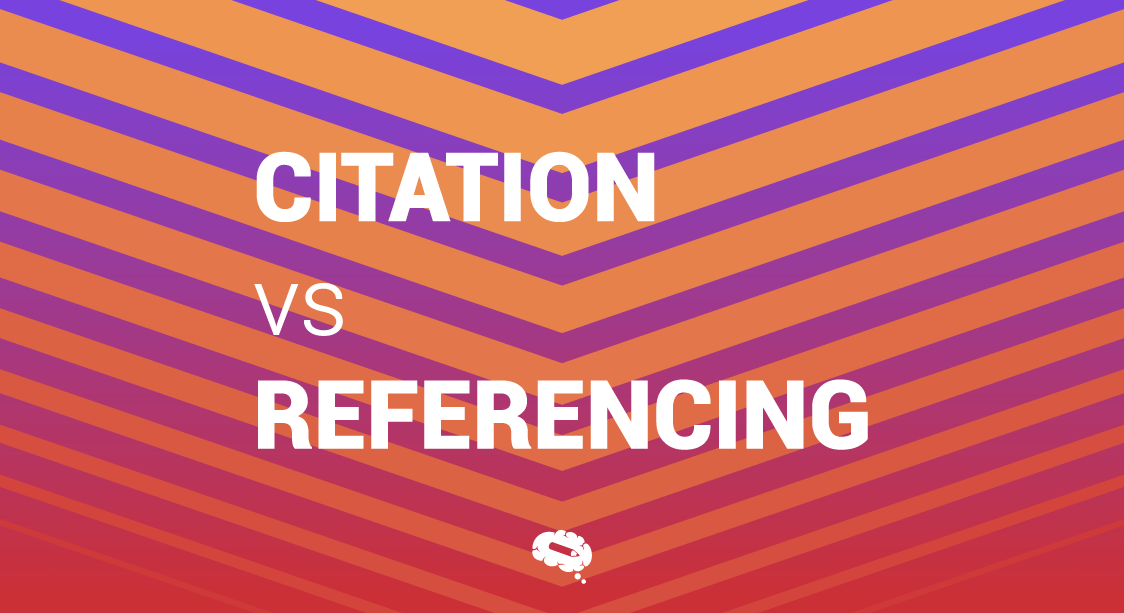Academic writing relies heavily on citations. Readers can see where your ideas originated as well as give credit to the original authors.
In order to succeed in the academic world, students, researchers, and academic writers must understand what a reference page is and what a bibliography is. Although both list sources, they are used in different contexts and follow varying guidelines depending on the citation style. By demystifying these two components of scholarly writing, this blog will help you decide which one to use in your next paper.
What Is A Reference Page?
The first step on this reference page vs. bibliography journey starts with the definition of a reference page. An academic paper or research document must include a reference page. Throughout the text, it lists all the sources that have been directly cited. Referencing in your work ensures transparency and academic integrity by providing readers with information about the sources you used. The reference page also helps readers find the original sources easily. Furthermore, it conveys to the reader the level of research you have done to support your argument.
Purpose And Importance
Reference pages serve as a way of giving proper credit to the original authors of the works that you have cited. By demonstrating the research foundation upon which your own work is based, this acknowledgment protects the intellectual property rights of those authors while also bolstering the credibility of your own work. Moreover, readers can verify your sources and gain a deeper understanding of your topic with a well-organized reference page. Key reasons why a reference page is important include:
- Academic Integrity: Avoids plagiarism by properly attributing ideas to their original authors.
- Authentication: Allows readers to check the accuracy of your information and follow your research trail.
- Research Depth: Demonstrates the breadth and depth of your research, showing that you have engaged with relevant literature.
Common Citation Styles that Use Reference Pages
Reference pages are used to organize and present source information in several citation styles. Two of the most common are as follows:
- APA (American Psychological Association) Style: In APA style, sources are listed alphabetically by the last name of the first author on the reference page.
- Chicago Style: In history and some humanities disciplines, the Chicago Manual of Style is used in two ways: the Notes and Bibliography system and the Author-Date system. The Author-Date system includes a reference page.
By adhering to the guidelines of the specific citation style you are using, you ensure clarity and consistency in your academic writing. (Read more about citations on our blog here)
What Is A Bibliography?
A Bibliography contains a comprehensive list of all the sources consulted or consulted during the writing process. This includes not only the sources that were explicitly cited within the paper but also those that contributed to the research process. Bibliographies are an important tool for readers to assess the credibility and accuracy of a paper. They also help readers to locate the sources cited in the paper.
Purpose And Importance
Bibliographies serve as detailed explanations of research backgrounds underlying scholarly works. Using a wide variety of sources, it shows the depth and breadth of the researcher’s research. Readers can verify the information, explore the sources further, and appreciate the researcher’s diligence and thoroughness because of this transparency. Bibliographies serve the following purposes:
- Credibility: It adds credibility to the work by showcasing the researcher’s extensive study and understanding of the topic.
- Acknowledgment: It properly credits the authors of the sources used, acknowledging their contributions and avoiding plagiarism.
- Resource for Readers: Readers can use the resource list to conduct further research on the topic.
Common Citation Styles That Use Bibliographies
Bibliographies are incorporated into several citation styles, each with its own rules for formatting and organization. Styles commonly used include:
- Modern Language Association (MLA): Frequently used in the humanities, especially in literature, languages, and cultural studies.
- Chicago Manual of Style (Turabian): Often used in history and the social sciences, providing flexibility for different types of sources.
- American Psychological Association (APA): Although most APA papers use reference lists, comprehensive or annotated bibliographies are sometimes included.
Key Differences Between Reference Page And Bibliography
1. Scope of Sources
References are only listed on the reference page if they were directly cited throughout the article. It ensures that all the works referenced within the text are documented, providing a clear trail for readers to follow for verification or further reading.
On the other hand, a bibliography lists not just the sources cited within the text, but also any other works consulted during the research phase. In addition to the cited sources, background reading, influential texts, and other materials could have informed the author’s understanding of the topic.
2. Citation Styles and Their Preferences
Citations in the social sciences are commonly formatted in the APA style. It strictly utilizes a reference page with in-text citations for each entry. Source information supporting the research presented must be precise and specific.
In MLA style, a Works Cited page, which functions similarly to a reference page, is typically included. A bibliography can, however, also be incorporated into MLA style when a comprehensive list of all consulted sources is necessary, such as in more extensive research projects.
3. Formatting Differences
Reference pages (APA style) are typically ordered alphabetically by the last name of the first author. Each entry follows a specific format depending on the type of source (book, article, website, etc.). The format of a bibliography (MLA style) can also vary significantly depending on the depth of information provided, as well as the order of entries alphabetically but may also include annotations.
It is very important to follow the rules for punctuation, capitalization, and arrangement of the elements within a citation in APA reference pages. Book titles should be italicized, periods should be placed, and author names should be formatted correctly. Though MLA bibliographies are also precise, punctuation and layout differ slightly. Book titles are italicized, and major elements of entries are separated by periods.
3. Usage Contexts
Reference pages are mandatory in academic papers, especially those following the APA style. The sources of information are clearly identified, which maintains academic integrity. MLA-style papers in the humanities usually have a Works Cited page, but more comprehensive research papers may include a bibliography to demonstrate the breadth of reading and research.
Research projects requiring extensive research and reading, such as theses or dissertations, commonly require a bibliography. Special attention should be paid to disciplines that value a wide range of sources.
A bibliography, which shows all the primary and secondary sources consulted, is essential to historical research. Through transparency, others can follow the researcher’s research trail and validate the research process.
| Aspect | Reference Page | Bibliography |
|---|---|---|
| Scope of Sources | Only sources directly cited in the text. | All sources cited and consulted. |
| Citation Styles | Common in APA, Chicago. | Common in MLA, Turabian. |
| Order of Information | Strictly alphabetical by author’s last name. | Alphabetical, may include annotations. |
| Punctuation and Layout | Specific rules for each element (APA style). | Slightly varied, depending on the style (MLA). |
| Usage Contexts | Academic papers, journal articles. | Research projects, theses, historical texts, |
By understanding these key differences, students and researchers can ensure that their work adheres to the appropriate guidelines and accurately reflects the breadth and depth of their research. Furthermore, they contribute to the ongoing scholarly conversation in their field by strengthening their own credibility.
Reference Page vs. Bibliography: Why They Matter
For several reasons, it is crucial to understand the difference between a reference page and a bibliography, including academic integrity, thoroughness of research, and plagiarism prevention.
Impact On Academic Integrity
In academic work, academic integrity refers to ethical standards and honesty. To maintain academic integrity, proper citation practices are essential, whether through a reference page or a bibliography. Citing your sources correctly allows you to:
- Respect the original authors by acknowledging their contributions.
- Research and rely on credible sources to strengthen your arguments and findings.
- Enhance transparency by allowing others to trace the origin of your ideas and verify their sources.
Reference pages and bibliographies cannot be confused or misused, leading to questions about the credibility and honesty of your work.
Ensuring Thorough Research
A well-prepared reference page or bibliography indicates the depth and breadth of your research. Here’s how each contributes:
- Reference Page: By listing only the sources you have directly cited, the reference page ensures that all information, quotes, and ideas are acknowledged. This focus shows that you have engaged directly with specific sources, allowing for a targeted discussion.
- Bibliography: A bibliography details all works consulted in your research. It shows that you have explored a wide range of materials, even if not all were directly cited in your paper. This breadth can enrich your understanding and provide a solid foundation for your arguments.
Using both methods demonstrates the thoroughness of your research, which supports your conclusions.
Avoiding Plagiarism
It is a serious academic offense to present someone else’s work as your own. Citations are crucial to preventing plagiarism. It is important to understand how a reference page and bibliography should be used to:
- It is important to attribute all sources properly, whether you cite directly or indirectly.
- Maintain consistent documentation to avoid unintentional plagiarism. By following the guidelines of your chosen citation style, you will minimize the risk of accidental misattribution.
- You can easily check your sources, verify the originality of your work, and be appreciated for your efforts to cite properly.
Also read: Plagiarism: What You Should Know and The Best Ways To Prevent It
You contribute to the culture of honesty and respect in academic communities by understanding and using reference pages and bibliographies correctly.
Utilizing Mind The Graph’s Tools To Save Your Time
Dive deep into your research and effortlessly craft engaging visuals that captivate your audience’s attention while also saving you time to make them visually appealing. From intricate data sets to complex concepts, Mind the Graph empowers you to create compelling infographics that resonate with readers. Visit our website for more information.

Subscribe to our newsletter
Exclusive high quality content about effective visual
communication in science.





